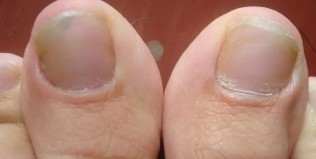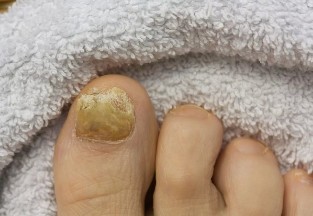You can hardly find a man, never heard about this disease, as the fungus of the nails. Someone familiar with the diagnosis of the advertising of pharmacological agents, and someone knew of the disease first-hand, leaving the office of a dermatologist or regardless of their diagnosis.

The definition of
The medical term for onychomycosis (lat. onychomycosis) is Latin for nail fungus, and is the designation of the fungal infection of the nature. It is more common in the world of the defeat of the surface of the nail and adjacent to it of the soft tissues: of the statistics of the world health organization (who) mycosis of the feet undergoes approximately 27 % of the people, a figure that almost doubles the number of mycoses of the nails in the fingers of the hands.
Types of fungal diseases of the nails
Onychomycosis is accepted to classify on the appearance of the affected areas. Due to a symptom of the classification is the of as you see the fungus in the nails, he distinguishes three types, depending on the clinical manifestations of:
- atrophic, or onycholitic – that nail plate is shocked, until the degree of rejection of the nail bed;
- hypertrophic type that have lost natural shine of the nail changes color (blanquece or, on the contrary, it darkens) and the structure (more severe is complicated by the emergence of all kinds of strains and even destroys the edges;
- normotroficheskie – type, characterized by the low of the defeat, in which the nail plate does not thicken, becoming glossy and soft, but outwardly is transformed due to the appearance in it of the stains, streaks and other visible changes of their natural transparency and colour.
There is another classification, according to which the fungus in the nails is subdivided into types, depending on the location of the defeat:
- total, that pathogens, the process of covering the nail plate;
- distal – the manner of defeat only in the free edge of the nail, which acts on the thumb;
- proximal, which destroys the edge of the plate to escape from underneath a roller (opposite the free edge of the nail!);
- side the form of the defeat, which affects the sides of the surface of the nail.

As you see the pathology
Common among the population of the mycoses of the nails have a similar external with other dermatological diseases are not fungal in nature. Depending on the stage of the pathology, the nails begin to look healthy, because they lose the natural shine and transparency.
Soft and smooth, become thick and deformed, and are covered in different colors (most often white or dirty-yellow) attack. Of the soft tissue, break down a parasite of the layer of keratin is also involved in inflammatory reactions, swelling.
If it is considered that the image of the destruction of the surface of the nail in view of the dynamics of the disease, it can be divided into a sequence of three stages:
- In the first stage there is no indication that, in addition to easy to tarnish, spots or stripes on the disk.
- In the so-called expressed stage, in rapid evolution, in the beginning, all the symptoms of onychomycosis is evident.
- Initiated the phase is the limit of the degeneration of the nail, can be complemented with the appearance of odours from the decomposition of the tissues.
The symptoms of nail fungus
The appearance of the symptoms of fungal infection corresponds to conditional on the development of the chronology of the pathogenic process, at a speed that depends on the specific type of excitation, and the characteristics of the health status of the patient.
As well as to determine the fungus in the nails before the visit to the office of a dermatologist? Thoroughly the symptoms that accompany fungicide defeat of nail plates in the fingers:
- First nail the discs lose their glossy shine, becoming dingy and rough.
- Then, transparent and pink nail changes color, becoming whitish, grey or dirty-yellow.
- The thickness of the plate increases.
- On the surface of an organ defects appear in the form of the bands of waves, slopes, curves, etc
- The nail appears brittle, it starts to exfoliate and crumble.
- Fingers due to the rise of inflammatory processes start to emit an unpleasant odor.

Finally, destroyed the nail is subjected to onycholysis, that is to say, the peeling, revealing pringtime bed.
The causes of onychomycosis
The pathology is one of the manifestations of mycosis, which depicts the defeat, in this case, the surface of the nail-organisms-dermatophytes-one (or several!) of the three genera:
- Microsporum (a type of canis);
- Trichophyton (types of rubrum – 90% of all mycoses mentagrophytes, interdigitale, and tonsurans) – the most common cause of fungal infections;
- Epidermophyton (type floccosum).
Representatives of the three births, united for the collective appellation of "the mushroom of the nail", when ingested colonize (i.e., localized) Heat derived from the epidermis of the skin:
- the nails
- hair.
The reason for this distinction habitat micro-parasites lies in their power: all of the representatives as a source of energy used fibrillar protein keratin, destroys the nails and the hair.
Forms of transmission
All types of pathogens pathogens are transmitted method of contact:
- the physical contact of an infected person to a healthy one;
- through the things that come in contact with the dead body parts (shoes, personal items, etc).
The contact with the nail or skin, became the dwelling place of the parasite, allowing the living to the representatives of the fungi entering areas healthy body.
At the same time, the causal agent of onychomycosis was able to carry out the infiltration in the human tissue, it requires conditions such as:
- damage to the integrity of the skin (dermatitis, diaper dermatitis, cardiovascular diseases, and diseases of the skin, abrasions, wounds, etc);
- weakened immune system;
- the presence of comorbid conditions (genodermatosis and hemolytic disease, the immune system and the endocrine system);
- reception of cytostatics and hormonal drugs, as well as antibiotics.

In connection with the foregoing, the penetration of the parasite in the body of a healthy person, not in all cases gives rise to clinical manifestations of the disease, or only very weakly expressed in the forms of the pathology.
In the light of certain individual conditions, including the strong immune defense, the man, being apparently healthy, he becomes the carrier of the parasite, infecting other people.
How to recognize the disease
By reason of the likeness of external mycotic lesions with mechanical deformations and symptoms of other pathologies surface of the nail, on the basis of clinical diagnosis lies not only the external signs — as seen fungus in the nails, and even and complement the results of the micro research.
For laboratory analysis are used particles of parcels affected nail, the production of scraping the nail fungus of any special tools.
A particular type of parasite is revealed through two of the easiest to research:
- the culture, through spaces biological sample of the affected tissue in a special broth of cultivation;
- molecular biological method, or the so-called polymerase chain reaction (pcr).
Most precise and informative of dna is not yet widespread.
In the answer to the question: "how do you recognize nail fungus at home", the dermatologists recommend all to go to a specialist for a comprehensive and, in its case, and the differential, diagnosis.
That dangerous fungus in the nails
Uncomplicated nail fungus the symptoms you are experiencing, although unpleasant, but traditional for the mycosis: a stratification of the nail, pain, etc
But, in some cases, mycotic, you can add, for example, a bacterial infection, or the disease may be acute, with the appearance of bubbles, ulcerations, weeping parcels adjacent soft tissues.
Happens, medication therapy, continuous performed in an outpatient setting (up to 16 weeks!), it is not ineffective, and the disease progresses.
That dangerous fungus in the nails of long duration does not submit to the treatment? In the inflammatory process that is involving the organs and their systems, and then it may be necessary emergency hospitalization of the patient.
Methods for the treatment of nail fungus
In the early stages of the disease the medicine adheres to the conservative methods, through allocations of drug treatment.
Anti-mycotic drugs to destroy the fungus underneath the nail, contain substances that may actively oppress the livelihoods of the different seals. To achieve an effective treatment can be used different ways drug, sometimes designated comprehensively:
- pills — to be taken orally (through the gastrointestinal tract, usually washed down with water), it is prescribed if you do not have the effect of the medicines;
- ointments, pastes and gels for the premises, all exterior, with the path of the drug directly into the infested of parasites in the body part;
- aerosols;
- solution (resorcinol, boric acid, green diamond, etc) and suspension, for the applications with the tool of napkins in the affected area, or the use of the drug in the treatment of the trays.
Medications for external use are usually used twice a day, until the resolution of the clinical manifestations. In the event of a keratosis to facilitate the penetration of the pharmaceutical form in the keratin of education made a partial detachment. If the symptoms of nail fungus show on the accession of the secondary, a bacterial infection, patients are recommended antibiotics combined.
Important! If they resort to the system of Anti-mycotic tools for the control of possible functional disorders necessarily produce the biochemical study of the liver (analysis of blood serum in the presence of bilirubin, in the presence of the enzyme elevated aspartate aminotransferase, gamma-glutamiltransferazy etc
If the patient, primary care, for example, the mushroom of the nail on the thumb, suddenly appearing acute inflammatory processes and/or itching, they resort to means:
- antihistaminicas (swelling and inflammation);
- desensitize (reduce the sensitivity).

The therapy through the use of pharmacological agents, as a general rule, is the course, and occupies a long period of time not less than three months!
This duration of treatment is explained by the introduction of the pathogen in the structure of the nail, so that it is necessary to update, with the gradual consistent in the circumcision of the affected areas. In the event that the disease is in a stage, in which the treatment does not give positive results (the form), or the patient is the person of advanced age to resort to the radical methods, eliminating surgically in the ruins of the parasite of the nail.
The prevention of the
The best treatment is a preventive intervention, because preventing disease is much easier than the first guarantees the availability of a fungus in the nail bed, and then get rid of it. A good way to prevent the infection acts in strict compliance with the rules of personal hygiene, especially in public places, at the risk of possible contact with native speakers of mycoses, as well as prevention:
- primary, by way of exception, the dryness, and abnormal skin, abrasions, trauma, and hyperhidrosis, and in the case of its occurrence – prompt treatment, for example, aluminium hydrochloride 15% with ditilinom glycol 1% to the increased sweating of the feet;
- secondary disinfection special mortar of the objects that come in contact with a focus of mycosis (shoes, towels, etc).
Correct placement of the information, from which it gets the fungus in the nails, it is realistic to protect yourself and your loved ones from infection and, in the case of the disease with adequate and timely treatment methods are able to speed up the recovery.





























